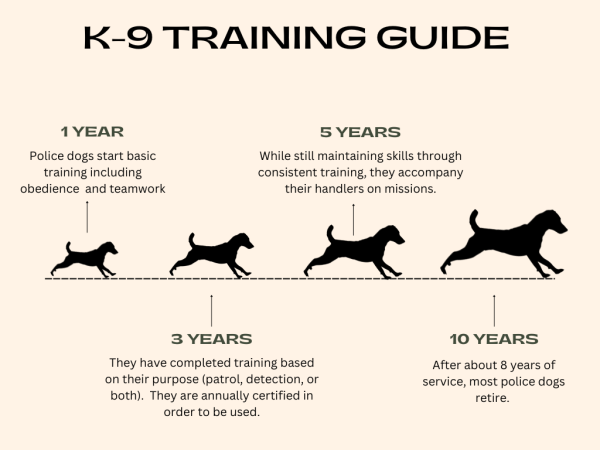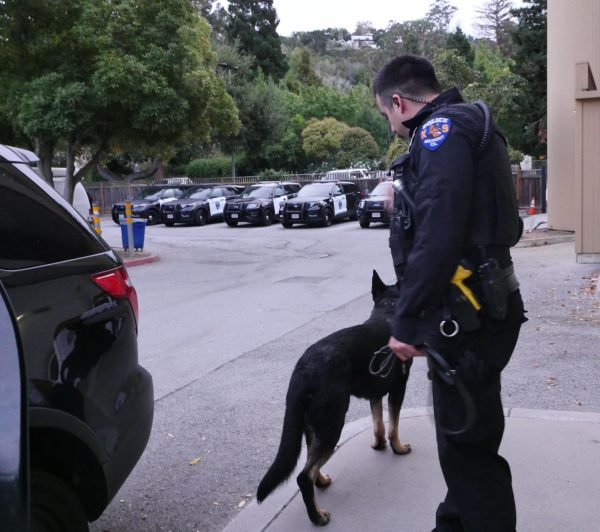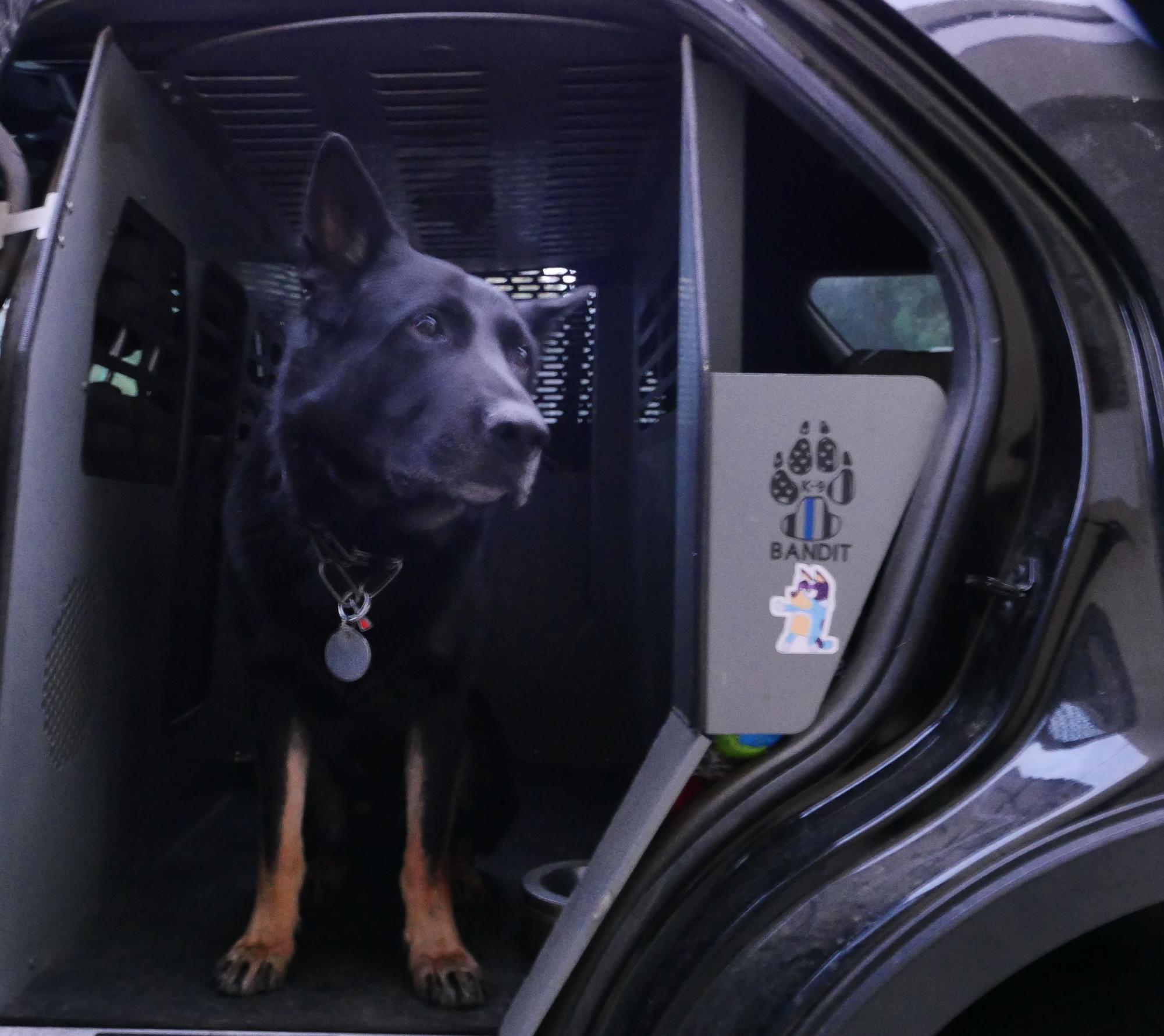Purpose, Passion, Partnership. These are the aspects of Belmont Police Department’s current K-9 team: Officer Adam Baggetta and his dog Bandit.
According to the National Police Dog Foundation, dogs can be trained as patrol dogs, detection dogs, or both. Patrol dogs carry the roles of officer protection, suspect apprehension, and security. Detection dogs are used to find narcotics or explosives.
Bandit, a six-year-old German shepherd, is from the Czech Republic. On paper, he is considered city equipment. Bandit has been working with Baggetta for three years and accompanies him on missions where his superior detection skills are needed.
“Not every call is a dog call, but it’s up to me to let my partners know what Bandit’s capable of,” Baggetta said.
Purpose
Bandit is used for narcotic detection and people tracking. He is trained through Trident K9 Consulting, run by the South San Francisco Police Lieutenant, Marty Mahon. To ensure his skills are maintained, he gets evaluated for an annual certification by an instructor from Peace Officer Standards and Training (POST).
Mahon, a certified POST instructor, describes the test as an indoor and outdoor search. If the dog finds the hidden drugs and the handler makes the correct call for the dog’s alert, they pass. A remediation test is usually given on the same day if the team fails, but the police department cannot use a dog unless they have passed.

Bandit is not used as a patrol dog, meaning he is not sent into a building to apprehend a suspect and potentially bite somebody. He is trained for cases like missing persons.
“If you were to walk through the park and to Ralston, and I start him right where you left, he would be able to follow you there,” Baggetta said.
In addition to missing persons cases, Bandit is trained to detect drugs. Detection training includes imprinting odors on the dogs so that they can identify them on the street. Bandit alerts Baggetta by holding his nose on the source. Baggetta has to read his body language, which is different for every dog.
“Even with my experience with animal behavior…it’s a lot to think about. It eventually becomes second nature once you know what you’re looking for, but there’s a lot of nuances,” Baggetta said. “There’s an adage among canine handlers that says ‘trust your dog’ because 99% of the time, the dog is right. It’s just the human error of not reading the dog properly.”
Passion
Baggetta previously worked for Animal Control in San Mateo County and was a cop before transitioning to K-9 work. He prepared to work with canines before a position was available within the Belmont Police Department. When the position opened, Baggetta applied, got interviewed, and got the job.

“Having people I knew and family members that have been in a K-9 unit before…it was something I wanted to do, so I aimed my career at that…A cousin of mine was in the South San Francisco K-9 unit…he helped me out by introducing me to people and taking me to trainings,” Baggetta said.
A police dog’s retirement depends on their health and ability to keep training. After Bandit retires, Baggetta is obligated to buy him for a dollar because of the fact that dogs are considered equipment.
Equipment cannot be traded after use, so unlike pet dogs who can be rehomed, police dogs remain with their handlers.
Most handlers and their dogs form close bonds over their years of shared service which is another reason the dog retires to their handler’s home. Bandit is not retired yet, but he is already a part of Baggetta’s family and goes home with Baggetta every night.
“My son, he’s 2, he loves Bandit. He calls him Cheeto which stems from Cheeto Bandito. I have other dogs at home that he gets along with,” Baggetta said.
According to Mahon, dogs know the difference between work and home based on association. They know when it’s time to relax if their collars or equipment is off, and when it’s time to work if their handlers put their collars or equipment back on.
“At home, he’s more playful because I let him play…when I’m at work, I don’t really play with him unless we do obedience work,” Baggetta said.
Partnership
Bandit and Baggetta spent their first month of partnership at a narcotics detection school. From 8 a.m. to 5 p.m., they did multiple searches and imprinted odors of different types of drugs on Bandit so he knew what to search for.
“It’s a game to him. Once he gets that, it becomes second nature to him,” Baggetta said.
Since Bandit is from the Czech Republic, his commands are in Czech. It’s easier for the handler to learn commands in another language than retraining the dog in English. At the start of their partnership, Baggetta was given a list of Czech commands with English translations next to them.
“He only really responds to me…that way, people on the street can’t command him,” Baggetta said.
Commands that are successfully obeyed are rewarded with play. According to Baggetta, Bandit could play tug of war all day long, so he is well rewarded in practice. Trainers refrain from keeping police dogs food-motivated, but the typical police dog breeds are already driven by work and play rather than food.
Mahon, who has experience working with K-9s and training them, says the key to a successful K-9 team is dedication and training.
“Even though they come to training once a week, I expect them to train their dog every day,” Mahon said.
Baggetta takes Bandit to training every two weeks for drug detection but also does his own tracking exercises. Sometimes, one of his partners will walk somewhere in the middle of the night, and Baggetta will tell Bandit to search for them. Extensive training pays off because Bandit has successfully found hidden drugs on the street.
“There’s no better feeling than having all the training and hours of work we put in pay off in the street by him finding something,” Baggetta said.



